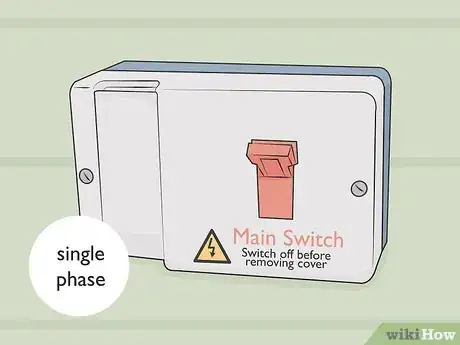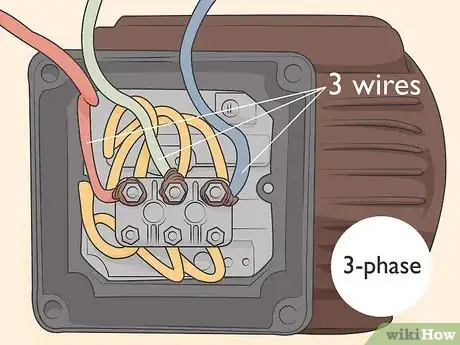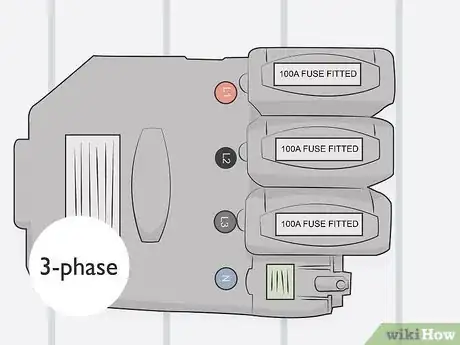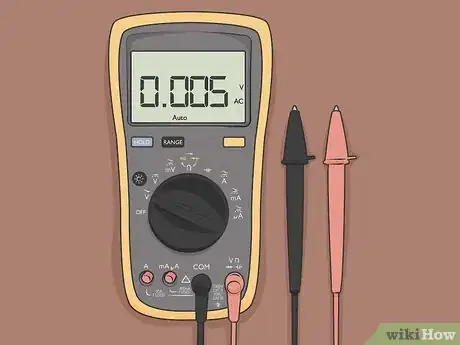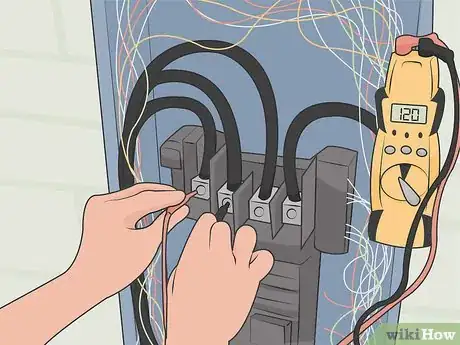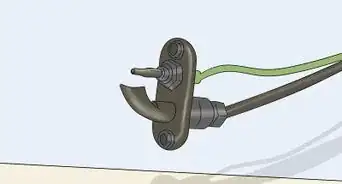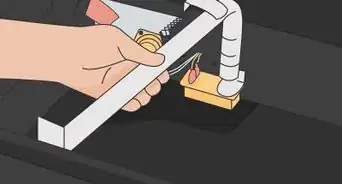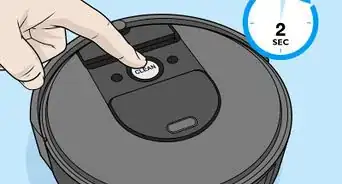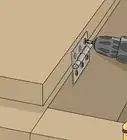This article was co-authored by Mantas Silvanavicius. Mantas Silvanavicius is a Licensed Electrician and the Owner of M+S Electric based in Las Vegas, Nevada. With more than 20 years of experience, he specializes in home electrical installations, testing, and wiring. Mantas and his team have completed projects for companies such as Seiko and Springhill Suites by Marriott. M+S Electric is licensed, bonded, and insured.
There are 9 references cited in this article, which can be found at the bottom of the page.
This article has been viewed 91,959 times.
If you’re planning on installing an appliance that needs a lot of power, or you have a blown fuse or electrical issue, knowing whether or not your building uses a single-phase or 3-phase power supply is important. Generally, most residential homes use a single-phase circuit and commercial properties that use high-powered machinery and equipment will have a 3-phase circuit.[1] But, there are a few ways you can check to be sure which type you have.
Steps
Inspecting Your Electrical Meter or Switchboard
-
1Read your electrical meter to see if it says single or 3-phase. Look near your fuse box to see if your meter is mounted next to it. Sometimes, the face of your meter includes information such as the wattage and the identification number. Look for a description such as “Single Phase,” “Mono-Phase,” or “1-Phase” to identify a single-phase or “3-Phase,” “Tri-Phase,” or “Polyphase” for a 3-phase supply.[2]
- Many meters will not include information about whether the power supply is single or 3-phase.
- Some homes have electrical meters in the basement, on the side of the home, or even in the front yard for energy companies to easily check them.
Tip: Your utility bill may also say what type of power you have. Check out a recent bill to see if it says single or 3-phase on it.
-
2Identify a single-phase power supply by a single pole. Find the main switchboard in your fuse box, which is the largest fuse usually located directly in the center of the box. Look at the width and the number of “poles” which are the individual circuits that the switch controls. A single-phase circuit will have a 1-pole. Single-phase power supply is mostly used for residential homes.[3]
- If you can’t find your fuse box, try looking for a metal box in your garage or basement, or check the side of your home outside.
Advertisement -
3Look for 3 poles to identify a 3-phase power supply. Count the number of poles connected to the main switch in your switchboard. A 3-phase power supply has a switch that controls the flow of electricity through 3 circuits, so there are 3 poles.[4]
- Three-phase power supply is mostly used in larger buildings example: warehouses, storage facilities, stores, condominiums, hospitals, and factories. Where more power supply is needed.
-
4Check for 2 wires for a single-phase or 3-4 wires for a 3-phase. You may be able to tell if you have a single or 3-phase power supply if you can see exposed wires connected to an appliance such as a water heater or oven. If you can’t see the wires connected to a device, look in your fuse box and find your main power supply switch, which is the largest switch that’s generally located in the center of the box.[5]
- In a single-phase circuit, there’s 1 live wire and 1 neutral wire. In a 3-phase circuit, there are 2 or 3 live wires and 1 neutral wire.
- The wires may be contained in insulation that makes it impossible for you to see them without cutting it open.
-
5Count 3 fuses for a 3-phase and 1 fuse for a single-phase power supply. Older homes and buildings may still use fuses instead of circuit breakers, which you can use to tell if you have a single or 3-phase power supply. The service fuses for your main power supply are usually located in your fuse box or mounted near it. They’re black and rectangular in shape. Single-phase circuits use 1 service fuse and 3-phase circuits use 3 service fuses. Count the fuses to determine what type of system you have.[6]
Checking the Voltage
-
1Set a digital multimeter to the AC volts setting. Use a digital multimeter with 2 leads to check the voltage of your electrical system, which will tell you whether you have a single or a 3-phase circuit. Turn on your multimeter and set the setting to read AC power in volts.[7]
- Make sure the red and black leads are plugged in correctly. The black lead goes into the terminal labeled “COM” and the red lead goes into the terminal labeled “V.”
-
2Hold your black lead to the ground wire connector. A wire connector is a small plate with a screw that holds a wire on your switchboard in place and is useful for taking readings. Locate the wire connectors attached to your main power switch. The connector on the far left is the neutral or ground connector. Hold the end of your black test lead against the connector.[8]
- Keep the black lead pressed against the connector.
-
3Touch the red wire to 1 of the hot wire connectors to take a reading. Take your red test lead and hold it against 1 of the hot wire connectors near the ground wire connector. Your digital multimeter should give you a reading of 120 volts. [9]
- Both single and 3-phase circuits have a reading of 120 volts between a hot and ground wire.
Tip: If you don’t have an accurate reading or any reading at all, your black lead may not be connected to the ground. Lift up your black lead and press it against the connector again.
-
4Use your red lead to find 208 volts if you have a 3-phase circuit. Lift up your black lead from the ground connector and touch it to another hot wire connector so both of your leads are touching 2 separate connectors. When both leads are connected, your multimeter should give you a reading of 208 volts if it’s a 3-phase.[10]
-
5Take a reading of 240 volts for a single-phase circuit. Press both the red and black leads against 2 separate hot wire connectors. A single-phase power supply should give you a reading of 240 volts on your multimeter.[11]
Expert Q&A
-
QuestionHow do I know if my building has 3-phase power?Mantas SilvanaviciusMantas Silvanavicius is a Licensed Electrician and the Owner of M+S Electric based in Las Vegas, Nevada. With more than 20 years of experience, he specializes in home electrical installations, testing, and wiring. Mantas and his team have completed projects for companies such as Seiko and Springhill Suites by Marriott. M+S Electric is licensed, bonded, and insured.
Licensed ElectricianTake a look at the main service coming into the building and see if there are 3 different phases marked on your main supply. You can also check the electrical panels in your building, as they will also be marked as 3-phase panels. If you still aren't sure after checking these spots, consult a licensed electrician for help.
Warnings
- Always use caution when you’re working around electrical wires in the fuse box to prevent accidentally shocking yourself.⧼thumbs_response⧽
Things You’ll Need
Checking the Voltage
- Digital multimeter with 2 leads
References
- ↑ https://sciencing.com/info-8679920-difference-three-phase-electrical-wiring.html
- ↑ https://www.oge.com/wps/wcm/connect/514cc3f2-c151-4b6a-ac97-3531791042df/Meter%2BStandards%2BManual.pdf?MOD=AJPERES&CACHEID=ROOTWORKSPACE-514cc3f2-c151-4b6a-ac97-3531791042df-lR2aGjY
- ↑ http://www.science.smith.edu/~jcardell/Courses/EGR220/ElecPwr_HSW.html
- ↑ https://youtu.be/hRjTEntEqqU?t=210
- ↑ https://www.energuide.be/en/questions-answers/what-is-meant-by-single-phase-or-three-phase-connection/1933/
- ↑ https://incompliancemag.com/article/double-fusing-or-fusing-both-sides-of-the-line/
- ↑ https://youtu.be/mox8RSI9-RU?t=45
- ↑ https://youtu.be/mox8RSI9-RU?t=55
- ↑ https://sciencing.com/info-8679920-difference-three-phase-electrical-wiring.html

